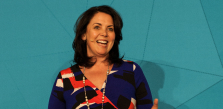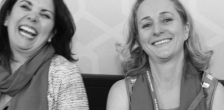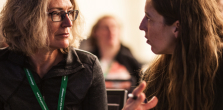It’s often the small things – the small minute-by-minute choices we make each day about how to spend our time and focus – that transform our lives into what we want them to be.
While it’s essential to have a big vision for your business and life, it’s even more essential to take action each day to get there.
In this video, Sheila Davis interviews me about my strategic planning process.
The biggest takeaway I shared with her is that strategic planning is not just something you do each year or each quarter, but something you do every single day as you decide what to do with you time, minute by minute and hour by hour.
It really is the sum total of all those small choices that lead you towards the life you want and allow you to achieve your goals.
NOTE: The technology gods were not with us the day we filmed this interview. If the sound quality bothers you, then check out the full transcript below.
INTERVIEW TRANSCRIPTS

Sheila Davis: A couple of months ago you actually posted a post that really helped me out. And I think it really helped the virtual assistants, and you’ve talked about strategic planning and I don’t know if it just hit me in just the right time but that’s something that I’ve struggled with and I’ve seen that a lot of virtual assistants have been struggling with it. They feel, they’re feeling overwhelmed, how do I figure out what I’m supposed to do next. So if you don’t mind, we’ll just talk about your blog post, Strategic Planning and if you can just tell us what your version of Strategic Planning is and how you do it, I love your butcher paper idea by the way. So if you could just tell us about that, that’d be great.
Marisa Murgatroyd: Well I guess the first step is to talk about is why strategic planning matters and what exactly it is. Before we go in the nuts and bolts of the process and all of that. So what I’ve noticed with the almost the vast majority of my students and the vast majority of my clients, that it’s actually really rare for someone to have a super crystal vision clear of what they want to accomplish in their own lives and in their business. So what happens is that we try all these different strategies and say yes to all these opportunities, we do a little bit of this, a little bit of that, a little bit of this, a little bit of that, and nothing big happens. It’s like the sum total of your actions never become more than just the sum total of your actions. It never hits that tipping point where that critical mass because it’s like the energy gets super diffused on all the activities of what it takes to run a business.
And a lot of times when you’re able to take that step back, and ask the hard questions of what do I really want , and why am I in business in the first place, what do I want my ideal life to look like, what do I want my ideal business to look like, what are the specific big picture goal or outcome and some kind of milestones along the way that will help me know that I’ve achieved that?
And the big questions to ask, and sometimes it can get to like a cat and mouse game because I think when it come to actually putting a stake in the ground, you know, drawing your land and lying in the sand and saying, ‘this is who I am and this is what I’m doing,’ it brings up so much fear, so much fear of choice, so much fear of failure, so much fear of success, so much fear of being seen. Because once you’ve got that vision to work towards, it’s like, oh my gosh, it’s no longer hiding, it’s no longer pretending to be in business, it’s like okay, here’s how I’m mobilizing my energy and the energy of my team and here’s how I’m making choices every single day, because of that vision, it’s not just about saying, I want to be a famous author, it’s about saying what’s it going to take for me to get that million dollar book deal? What’s it going to take for me to get to number one on Amazon? Or number one in New York Time Bestseller List? And once you start to ask those questions and you evaluate the things that come up in your day that says, will this move me closer towards my goals and my outcomes? Yes or no. And of course there are a lot of reasons to say yes or no to something. It could be, does that move me closer to my outcome or is it nurturing the relationship important to me.
For example, I’m doing this interview today ‘coz your one of my students and I like to support my students when I can. That’s important to me. So even though it’s not moving me towards my outcomes, you know, maybe you’ll have a little bit of visibility it will give me, but I’m doing this for you and for the relationship that we have and to support you and your work.
Sheila Davis: Thank you for that.
Marisa Murgatroyd: You’re welcome. So it becomes a level of intentionality and consciousness in the choices that you make rather than just like scurrying around and like, ‘I need to grow my list, what I can do to grow my list’, there’s no real reason behind growing the list for example. So then when it comes to setting up communications, the list is all scatter shot. And when you don’t have that clarity, nobody else has that clarity. They don’t know why they’re following you. And you’re not giving them consistent, congruent value where your signals are aligned, where you really know what you’re talking about why you’re talking about it and it’s pointing in a particular direction of where you want to take your business, where you want to take your life, how you want it to make an impact with other people’s lives.
So for me, without having a clear vision of what I want and strategic planning is part of the process that uncovers that vision, it’s like trying to find your way from, you know, Mexico to Canada without the North Star, without a compass. It’s impossible. You’re going to get lost, and you’re going to feel overwhelmed. You’re going to take wrong turns, and that’s kind of part of the natural process anyway. But that vision always guides you back, to one of my, what do I need to do here? And that vision is not just necessarily what do I want to create? It’s what I would love to create. What would make my life on this planet, happier and richer, and more joyful. What would express who I am in the world? And what would make the most dramatic impact for the people who are following me and the people that I serve?
So, all of these bigger picture questions are part of strategic planning for me. And I don’t think that anybody can have a successful business without that clarity of vision of where they’re going. So they can put one foot in front of the other and wake up each day and make the kind of choices that will bring them what they want.
And so this is… Yeah. What we’re talking about is, like, mission critical. And it’s the last thing that you’ll hear people talking about when they’re like, ‘yeah, start your podcast, you know’ or ‘get on Facebook’ or ‘why don’t you start sending your newsletters?’ and what you see is a lot of people spinning in circles getting really frustrated and overwhelmed because they’ve never really asked those hard questions, and it doesn’t have to be hard.
And so, now what is strategic planning? Strategic planning has two main components for me: the first component is identifying that vision of what you want and why you want it and it doesn’t have to be single thing, it can be a collection of things. But I tend to like to encourage people to come up with what I like to call their Olympic vision. That’s equivalent of standing in a podium with a gold medal around your neck, and the reason why I encourage people to come up with that Olympic moment, is that it really is a vision that you can call to mind whenever you feel frustrated, or discouraged or lack of clarity, so you know so that you can reconnect to why you’re doing what you’re doing and how that would feel.
And then of course there are a lot of sub goals and things that could happen which might be okay, that particular amount of money coming in and things like that. But to connect to the juice and motivation behind why you do what you do.
So first it’s about the destination, and then you got to look clearly about, at your starting point. Where are you now? So if you think this is the ideal vision, picture of my business and my life, and I say this is what my life looks like right now and it’s not a process of judging yourself or beating yourself up or saying why haven’t I gotten where I want to go, it’s about saying being realistic and saying, ‘okay, this is where I am, this is where I want to go, now how do I get there? How do I bridge the gap between where I am now and where I want to go? Without this whole feeling or negative charge around, oh my gosh, I’m too old, you know, I’m not ready but just realistically saying, okay, here’s where I am, here’s where I want to go.
And that’s the big picture vision. And I go kind of outcome by outcome. Okay, I’ve got, say, a thousand people on my mailings list; I’d like to have ten thousand by the end of the year. Alright, I’m making $3000 a month; I’d like to be making ten thousand dollars a month.
And once you start to see not just the big picture, but outcome by outcome, some of the milestones along the way of where are you are and what you want, then you can say, okay if it takes 10,000 people on my list to actually give me the income that I want, how do I get to 10,000? You know, what are the specific actions between each of those milestones, between each of those goal post to bridge the gap.
Alright, so I want to go and I did that. I had I think three or four thousand people at the beginning of the year on my mailing list, and now I’ve got 13,000. And my goal was to have 10,000 by the end. It was massive growth. So I thought about what are the list building activities that I can do. I’m going to need to do one big list building activity every single quarter to help me reach that goal. I’m going to need to form partnerships around each of my launches to help meet that goal and to reach additional students and clients. The organic growth that’s just waiting from person to person to hit my website it’s not enough for me to that goal even if I’ve got great content that has people coming in from Google.
So then I plan, okay I’m going to do this list building activity, and this list building activity, and then this list building activity. What’s it going to take to fill my programs? How often do I have to launch? How many partners do I need to have? How do I need to get the promotion out there to have that many people say yes. And I just go item by item through and I figure out what I need to do. And that’s not just about what you need to do but it’s also what you need to stop doing because from an energy management and the time management perspective, whether you agree on time, whether time management exists or not, you know? That’s a bit of a debate.
You got to say, okay, I’ve got a finite amount of time and energy to spend on this. And the reality is I’ve got other things going on in my life too. I’m a mom or I’m a wife or I’ve got to take care of my sick mother, whatever happens to be that’s going to take that time, how much time do I actually have to spend on these activities? You could say okay, I’ve got ten hours a week. So then what you’re going to have to do is start prioritizing the actions. And I teach things like in opportunity particular spreadsheet where you can put all of these different, possible activities that you can do into a spreadsheet to figure out which one is the most important one now? Which is the one that’s the bottleneck? Or which is the one that’s going to allow other things to happen afterwards? What is that one activity or that one thing that you can do that’s going to move the needle to most of your business right now? And then focus your energy to really achieving that rather than trying to kind of move each one an inch forward –how can I move one of these ten feet forward.
And you might be able to do more than one at a time and it really depends on your schedule and your flow. And once you do that and you really have those clear priorities, then you’re be able to have that and waking up each day saying, what do I need to do today? What’s the big thing that I need to move forward in my business, not just how can I empty or clear my inbox. That may be part of it and then you can build your schedule and the ideal flow of your day around that, okay, so I’m going to take from, you know from 7am to 9am to just really get into the day and make sure that I’m mentally and physically prepared for the day, then I’m going to take from 9am to noon to really work on those key priorities. And I’m not going to open my email until after lunch at 2pm, and I’m going to use 2-5pm for maintaining the business and for answering all the different emails and things that are coming into the business.
And when you do that, when you got that kind of laser focus and that clarity of what you want to achieve, you become unstoppable. And it’s no longer about making excuses, no longer about wasting time or procrastinating, or feeling overwhelmed, you know what you got to do it’s just about doing it and putting the structures in place in your life to help you do it.
Then of course thinking about what can I stop doing? Alright, I have 10 hours, I feel like if I have 15 hours, my growth would just be a quantum leap from where it is now, how can I create 5 more hours in my schedule? Is there a way I can get someone else to do the laundry? Is there a way I can get someone else to cook or can I order food to be delivered. Now one of the things that you can do to start growing that amount of time that you’ve got to work on things without killing yourself.
And these are all the kinds of questions that I ask. It’s not a process of simply opening a spreadsheet, it’s not this technical process of hiring a consultant, and it’s really about tuning in to what you want. And then understanding the most efficient path to get there and then putting in place the structures and support you need to make it happen.
Sheila Davis: Right. I think that’s really important for virtual assistants is having that support I know this week on the Facebook group there’s been a lot of moms who’s saying that they need some support, some direction. And so I think that the information that you’re telling us, I mean that whole concept that you just talked about is something that every single virtual assistant is needing right now.
From everything that I’ve been reading, is that they just need to figure out how to get, I think if you have a plan, like you said, have the plan, do the strategic planning and figure out how you can map it. If you only have 2 hours a day, what are you going to do in those 2 hours and plan the day before your big project that you’re going to be working on and do that. So excellent advice.
So how often do you do strategic planning, would you recommend redoing that and doing target focus on what you’re looking for.
Marisa Murgatroyd: Sure. This is something I definitely revisit at least once a quarter and when there’s a need. When I feel like things have shifted in the business and I really need to get a new clarity on what we’re doing, when I need to step back and have that clarity. But it can happen more often as well.
And there’s also a little bit of strategic planning that happens every single day, honestly, when I decide on my to do list. So there’s the big picture, the big vision planning and then there’s the kind of the daily planning where, okay, so these are the most important things for me to focus on today, these are the types of meetings that I need to have and these are types of meeting that I don’t need to have. This is what I need to ask my team to do as well, so I can focus on these things. And looking forward to saying, okay we got this event, this event and this event coming up, what do we need to make happen to make each of those things a success.
So this is something that I really, really do every single day, as well, once I’ve got that big vision in place, I’ve got it re-calibrate and evaluate everyday how do I spend my time. And it doesn’t always work. I mean there are times when I’m thrown a loop or something happens or a new opportunity drops in my lap that I say yes to, or my energy’s not up for it. But for the most part, I’d say, you know 9 times out of 10, I get done what I need to get done that day.
And I don’t let myself get too spun on everything else that’s happening. On everything in my inbox on everything that’s coming at me through Facebook. And the more I put in place the structures for other people to handle that as well. So that focus is really, really, really powerful and I genuinely believe that any of us regardless of our life situation, can make anything we want happen if we do this kind of work, if we do on a daily basis, and not just leave it for those, okay it’s January 1st, what do I want to achieve in the year, and put together some lofty goals and I’m like, you hang it on the wall and you never look at it again. You know this is really about looking at every moment of every day, to kind of optimize your life to make it happen and to gather and put in place not just the schedule and to do list and the check list and the outcomes but also gathering your internal energy and force around it to really make it happen.
And I know, I’ve tripled my business every year for the last two years and now we’re on track to hit half a million this year. And it’s not about the money, I mean, that is the goal that I’ve got, it’s primarily about the impact and also making enough that I can live the lifestyle and have the support that I need to keep giving in a larger and larger level. To be present, to show up today in this interview and be fully here with you, that I feel rested, I feel connected to my inspiration, I know what my message is, I’ve got that clarity I can speak about it, I can be on my voices, not scratchy, I’ve got the energy, all of these things are what allow me every single day to show up and really make it happen and it’s stuff that everybody needs.
And when you connect to that vision, and you actually do the kind of strategic planning to understand what you need to do not just over the course of a year but down to the level of every single day, then you can make amazing things happen in your life.
Sheila Davis: Agreed. So, let me make sure I understand, so maybe a good way to do it, so you are going to do your strategic planning every day, whether you do it in the morning before you go to bed at night so you’re prepared for the next day but you need to do that a little bit everyday and then maybe every quarter. I was thinking for myself, the way that I was doing it, every time I hit that milestone that I’ve been working for after my last strategic plan, is I do another strategic plan. Now what am I going to do. So I usually carve out an entire day and I’ll do, I’ll go and I write down and I write down the things that I’ve been thinking of and then I go clean something and then I go back and then write down, so I basically plan out a whole day. Is that how you kind of plan the whole day?
Marisa Murgatroyd: it is not always a formal process. I want to show you my, like my documents that I actually work from are total mess. I’m left handed, I’ve got that handwriting, I’m not like organized from everything in its place kind of thing but at the same time, running a mid six figure business. So this is actually what my everyday looks like. You see all these?
Sheila Davis: Yeah, it looks just like mine.
Marisa Murgatroyd: it’s a total mess, it’s not organized and I just highlight, I circle, I put stars on it, I cross things off, I add new things in the corner, sometimes I got a phone number down, like I’m on the phone and I just jot it down, it’s got coffee stains on it – it’s a freaking mess, right. And at the same time, this is enough just keeping this running list.
Look, every time I think of something, I write it down. So it might not be the thing for today but I get it on paper so I remember this is something that I got to come to, so don’t drop balls. Okay, I’m going to do this interview with you today so I need, you know, 5 minutes, to prepare for the interview, ahead of time. So it’s on my list. It’s on my list for today. Coz I don’t have to do it the day before or the day before.
So a lot of times, it is very last minute for me in terms of everything happens precisely when it needs to happen. I’d love to get to the point where I got the luxury for everything to be done well ahead of time, so I don’t have to be rushing against deadlines. But the reality is that we’ve taken on so much.
That that’s what my life is, you know, say, okay, these are the things that have to happen today, because there’s one particular deadline, or because I’m participating with a partner, because an email has to go out and I have to stay on my marketing calendar and I’m delivering a course so I have to hit certain milestones in the course delivery and I’m juggling this constant puzzle, okay these are all the things that have to happen, which ones have to happen today and it’s going be the combination of the urgent, just because the newsletter does have to go out tomorrow and that’s urgent just because I got to continue to nurture my list for them to continue to respond to me. So I’ve committed to trying to email twice a week. You know, with value.
So that means Sunday night a lot of times, ‘coz I send out the newsletter, say on Monday, I’m writing a newsletter, I’m writing a blog post, or whatever it happens to be, I will get to the point where I’m farther ahead to the point, but the reality is that sometimes you want to go out and see a movie and where you want to go and do something really fun.
So it’s always for me that juggling act between what has to happen because I’ve ma de a commitment, or because people are waiting on me, and what I need to do to move that bigger picture stuff together and one of the things I do personally for myself most of the time, is that I only try to take calls on Tuesdays through Thursdays from 1pm to 6pm with other people.
Sometimes it’s not possible if we’re on a launch and we’ve got to talk to partners and things like that, but if it were possible, that’s what I would try to do. That means I’ve got from Friday to Monday and my mornings to create and focus in that bigger picture. So I’m literally structuring my days to support growth and movement towards my big picture.
You know sometimes I’ve got to handle urgent things in the mornings rather than big picture stuff and if it were possible I try to maintain that integrity of that time, and that just structuring myself for success, scheduling myself for success is the big part of how we’ve been able to kind of launch multiple, multiple things this year and bring in the revenue.
Sheila Davis: Right. Well I think a lot of virtual assistants I know for myself, I’m feeling so much better about how my life, it’s like you said it’s like I’m doing this and I’m doing that, and I’m feeling a little, like I’m pulled in different directions, although I do schedule certain amounts of blocks of time to do certain things, where I don’t look at my email, I don’t look at those little red buttons on Facebook ‘coz a little ocd comes in to play when I go to Facebook and I see a little red button I think I have to click it.
And so I think that knowing that someone as successful as you struggles with those same things and how you have figured out and how to overcome those is really helpful. So I have a question for you, it’s a little bit off of strategic planning ‘coz I think what I would like to do is pass on a link on to your blog post about strategic planning, where you lay it out, it’s a great blog, it’s very detailed and the virtual assistants will hopefully go and look at that and be able to do some strategic planning on their own and get their focus.
So kind of switching gears a little bit, so you started out with, for me, you started out as a coach. I bought your coaching program. And you’ve moved more into mentoring type where I don’t really do so much coaching with you as I do as more of a mentoring thing, so for example learning how to do strategic planning for your blog posting, so what is the difference between finding a mentor and finding a coach? So they may need your coaching program, your training program, but maybe they can’t afford that and they are just going use you as a mentor. What kind of is the difference in having a mentor and a coach I guess.
Marisa Murgatroyd: I think we might define it differently so I’m not quite sure with the distinction for you but I consider myself more of a consultant and more of a trainer than I have a coach. Like I’m really, you know there’s naturally some coaching involved in it ‘coz a lot times what has my students talk is some personal block, some lack of clarity that requires a little bit coaching, but I primarily consider myself more of a trainer and of course, there’s a lot coaching in my programs.
Message to Money and Hidden Story Power are primarily online training programs. Message to Money in particular has a coaching component where people can show up and ask questions and I can guide them through a process to help them figure out what their message is or how to fine tune their website to make it even more effective, so in that way, I call that a coaching call but it’s also is, kind of, consulting with them too.
So I’m not sure in terms of the difference that you are putting forth there but I would say any kind of coach or mentor that you choose is someone who’s built what you want to build. Who’s been there, who’s done it and come out the other side successfully not just someone who talks about it, or someone who has book knowledge about it, but someone who does it. And I think one of the things that distinguish us, is that I literally do this work, one on one for a lot of very successful entrepreneurs every single day. So I’ve got clients who are mid 6-7 figure entrepreneurs who I helped to rebuild their brand, to rebuild their web platform.
So I’m not just talking theory. I’m talking about stuff that I’ve seen works. That works for me that’s helped me go from $58,000 a year to almost $500,000 a year. So that’s I think, for me, what real mentoring is about is finding someone who has been there, who’s done it. Who’s come out the other side. They’re not necessarily fully enlightens human beings or anything like that, but they’ve got a lot of wisdom to share that can help you shortcut the process, and get faster results. And also somebody that you feel a certain amount of rapport and connection with, where there’s a personality match because not everybody’s coach or mentor is the right mentor for you and I‘ve had that happen before when someone joins one of my programs and hires me and it’s like a battle. And whether it’s me or whether it’s them or it’s a combination of our energy, it’s not the right match. And that’s going to happen sometimes. Just because of what you need or the style of teaching is not what that person gives. And that person can’t become someone that they’re not in order to support you and also there’s a kind of readiness to be supportive. I think that some people are so in the thick of it, that they’re not able to be coached. They’re not able to distance themselves and hear the truth of the matter and they want to kind of fight or resist or be defensive or reject or instantly say ‘No, that’s not going to work, that’s not going to work, no this is who I am.’ And obviously, if you hire someone, as a coach or as a mentor or as a consultant, you want to approach it with a little bit of beginner mind, you want to approach it for what can I implement here. ‘Coz nothing that anybody teach is going to be a hundred percent the right fit for you and I think there’s a lot of giving up personal responsibility once using coaches and mentors and trainers and signing up for products, as if this is the magic bullet solution that’s going to give you success, but it’s taking what’s being taught and actually putting it into action and thinking about how does this relate to me, what can I pull out of this? How can I not just learn this intellectually but put this into action in my business.
It’s not just straight forward, okay listen to the thing, implement. You got to do a little bit of work to figure out, okay, how can I take this and really apply it in a specific custom way to my situation, and I feel like so many people do just advocate personal responsibility and expect that they’re going to have a pill to swallow that all of a sudden that’s going to fix everything and that never works. That’s why you see coaching programs or training programs that people drop out of or people buying program after program looking for the solution, when it has nothing to do with program. Sometimes there are some bad training programs out there. And I’ll say that. But it has to do with that willingness to engage, learn to do the exercises, willingness to implement and also the willingness to take that spark and that seed and nurture it in a way you need to nurture it and apply it in a way you need to apply it.
And I’ve had people come and say, oh I’m stuck with an exercise, then I’ll say well then just skip it. If that’s not the right exercise for you right now, go to the next one, which is the one that you are there and I call it, really, a program where people can choose their kind of adventure to. I think approaching every single bit of consulting or mentoring as you choose your own adventure coz it’s super dangerous to just take exactly what someone says and to try to fit it exactly into your business without considering your own personal needs and wants and desires and what you’re hoping to achieve and which pieces of that are going to work for you. If you just can’t stand to be on video, and that video blog course that you bought, maybe it’s not the right course; it has nothing to with teaching but has something to do with what you want in your own personal strength and tendencies and preferences.
And that’s the thing that I see most often is that people likes to place responsibility in their trainer or mentor that’s really their responsibility. And nobody can pull you across the finish line, they can only give you the opportunity and the tools and resources to bring you success and to help you shortcut that journey.
Sheila Davis: Right. You know my next question was going to be what makes a great mentor and you really answered that because I know that for myself, before you’re actually the only coaching program I’ve ever purchased. I’ve never purchased any other coaching program and the reason I purchased yours is because how you laid it out. I think I attended three webinars of your before I decided. And you’re so right. If I took your coaching program and I’ll be the first to admit, I have not watched every single module. I have not time. Because I want to make sure that I’m in that stage of my business as I watch and learn from them. But if I took those and the very first time you and I ever talked about my website and you told me, you got to get rid of the frog, nobody’s going to know what the frog means, if I had taken that with a negative attitude that you were talking about, and say, ‘well, well, well,’ and you know, complaining instead of taking that criticism or its not criticism, it’s a, what’s the word?
Marisa Murgatroyd: it’s feedback.
Sheila Davis: Feedback. So if I had not taken the feedback in the correct way, I might not have the image that I have now. And honestly, once I changed my image, I has results. So it’s a matter of what you do with what your mentor provides you so as the coaching. And I agree with you and I think that consultant is so much more, a better word for what you provide than coaching.
I haven’t thought of using that word. But that’s a much better word. So,
Marisa Murgatroyd: and there’s a good deal of mentoring ‘coz I do provide a lot of support for my people, and a lot of what I do is not just nuts and bolts of how to, but it’s the inspiration and the big why and that over-arching message which is what my business is about is that you can build a business that fully expresses who you are in the world and have more impact, more success, more financial reward than you could ever imagine, just by doing exactly what’s in your heart to do. If you’re able to step up and learn the tools and strategies and also find that alignment or that congruence between who you are and how you express yourself through your business. And I teach that so a lot of what I do is about motivating and empowering people to build the kind of business that they really imagined and dreamed of having. And so if I just taught, without telling stories, without that motivation and inspiration, it will fall flat.
If I just answer your question about, okay this is how you do strategic planning, you noticed you asked that question, I backed up and I contextualize it. Because if I didn’t do that, people would’ve tuned off or turn this off and it would’ve been boring, right?
Sheila Davis: Right. Absolutely. I totally agree. I don’t know what’s up with my light, I apologize. All of a sudden it looked like I was glowing. And you are very accessible I know on your Facebook group is that people are asking you questions and then they tag you and you’re responsive and you know, I asked you for the interview and you responded to that and we had our one on one session and I don’t find that your absent by any means in your program. So anyone’s who’s considering your program, Marisa’s a great one to go for, even though her teaching is not specific for virtual assistants, it has ultimately grow my virtual assistants business and I know you got a lot of virtual assistants actually..
Marisa Murgatroyd: I got a ton.
Sheila Davis: Yeah, there’s a lot of virtual assistants in your group, I know quite a few actually that are there and it’s also a great place to network. Because there are so many different types of businesses, it’s a great place to network as well. But you learn oodles of information. So, Marisa, I appreciate your being willing to chat with me today, and do an interview for the virtual assistants, I think, click the links below everybody and take a look at her program, you’re not going to be sorry, you’re going to find something – an answer to a question that you’re having or whatever. And do your strategic planning. And shoot us an email and let us know how you’re going with that.
But Marisa, keep us posted on how things are going and we look forward to hearing lots more of your message.
Marisa Murgatroyd: Thank you very much and thanks for having me and definitely this is, no one’s asked me to do an interview about strategic planning before so it’s my primary thing is messaging but then at the same time, I have people say, oh my gosh, you’re the most productive person I’ve ever met or how can you possibly launch 5 things in one year? And this is the secret to it.
So it’s one thing to have your messaging and positioning down, and that’s why actually strategic planning or what I call your Roadmap to Freedom is the very first module that I teach everybody – ‘hey, wait a minute I thought I was on a messaging course’ or ‘hey, wait a minute I thought I was in a branding course’, well, if you just do message and brand without a vision, it’s like, it’s just words and pictures. But it’s your vision that drew a line for your entire business and all of the actions that you take from day to day basis, so that message, that web platform, that marketing, has to all be in service in making that vision come true. And when you’re on purpose, people can feel it.
Sheila Davis: Absolutely, the very first module that you have, I think it came it with what, probably, about 30-40pages of questions, well they’re not all questions, there were like 2 or 3 questions per page, so 30-40 I don’t remember how many pages but I know I took an entire week and I really took a step back and cloud through those and I answered every questions as detailed as I could get and it really helped me so that is I guess that is sort of a strategic plan that you offer there at the very first step. So I appreciate it, I know the other virtual assistants will appreciate it as well so I appreciate your time, I appreciate your emails and everything else that you provided to me through your coaching program and look forward to what we do in the future.
Marisa Murgatroyd: absolutely. And I want to say one more thing, which is, this is what separates people who are going to be successful in business from people who are not. This is what separates people who dabble in the idea of having a business because they like the idea of it from people who actually go out there and make a huge impact and start to have the financial rewards. ‘coz everybody says , yes, I want to make a great living, yes I want to have a passive income yes I want to do this but if you look at your daily actions, you’re not really taking actions you need to make that happen there’s nobody to blame but yourself, you know, nobody. I think that’s what people kind of make the mistake of thinking, ‘alright, I have passion, I’ve got energy, I’m want to have a business’, but this is where the rubber meets the road.
Sheila Davis: Right. Absolutely. Totally Agreed. Well, thank you for all of that information. I will be sure and get with you to make sure that all of my links I’m adding are correct and up to date and so everybody can go and join your programs and be a part of that Live Your Message and the Hidden Story Power, which is I really struggled with the Story Power and if you’re starting with your Story Power, get on the program because you see you’re not the only one and she guides you through providing your story. Coz like you said, Marisa, it’s all about connecting, the sales comes later and it comes easier if there’s a story behind it. Absolutely.
Marisa Murgatroyd: Thank you. Now go out there and Live Your Message. Bye!
Love it? Hate it? Let me know...
-
Hello There. I found your blog using msn.
This is a really well written article. I’ll be sure to bookmark it and return to learn more of your useful information.Thanks for the post. I’ll certainly return.
-
Now that you know what is going on inside you, goal setting is the next indispensable thing
to accomplish. It notes specific areas of development to look for and what tendencies as an individual to avoid.You can use this document to identify a niche in the market and locate a customer base you wish to target.


























Leave a Comment